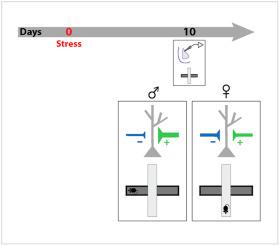Neurobiology of Stress ( IF 5 ) Pub Date : 2021-01-07 , DOI: 10.1016/j.ynstr.2020.100292 Kanika Gupta , Sumantra Chattarji

|
There is accumulating evidence that stress triggers specific temporal patterns of morphological plasticity in the amygdala, a brain area that plays a pivotal role in the debilitating emotional symptoms of stress-related psychiatric disorders. Acute immobilization stress is known to cause a delayed increase in the density of dendritic spines on principal neurons in the basolateral amygdala (BLA) of rats. These neuronal changes are also accompanied by a delayed enhancement in anxiety-like behavior. However, these earlier studies used male rats, and the delayed behavioral and synaptic effects of acute stress on the BLA of female rats remain unexplored. Here, using whole-cell recordings in rat brain slices, we find that a single exposure to 2-h immobilization stress leads to an increase, 10 days later, in the frequency of miniature excitatory postsynaptic currents (mEPSCs) recorded from lateral amygdala (LA) principal neurons in male rats. Further, acute stress also causes a reduction in the frequency of miniature inhibitory postsynaptic currents (mIPSCs) in LA neurons 10 days after acute stress. In striking contrast, excitatory and inhibitory synaptic transmission in the LA of female rats does not exhibit any delayed change despite exposure to the same acute stress. Finally, we examined the functional impact of these contrasting synaptic changes at the behavioral level. Male rats exhibit a delayed increase in anxiety-like behavior on the elevated plus-maze 10 days after acute stress. However, the same stress does not lead to a delayed anxiogenic effect in female rats. Together, these results demonstrate that the delayed modulation of the balance of synaptic excitation and inhibition in the amygdala, as well as anxiety-like behavior, differ between males and females. These findings provide a framework, across biological scales, for analyzing how affective symptoms of stress disorders vary between the sexes.
中文翻译:

急性应激对杏仁核的延迟影响中的性别差异
有越来越多的证据表明,压力会触发杏仁核的特定时间模式的形态可塑性,杏仁核是在与压力有关的精神疾病的虚弱情绪症状中起关键作用的大脑区域。已知急性固定应激可导致大鼠基底外侧杏仁核(BLA)主要神经元上的树突棘密度延迟增加。这些神经元变化还伴随着焦虑样行为的延迟增强。但是,这些较早的研究使用的是雄性大鼠,急性应激对雌性大鼠BLA的延迟行为和突触影响尚待探索。在这里,使用大鼠脑切片中的全细胞记录,我们发现10天后一次暴露于2小时固定压力会导致增加,雄性大鼠外侧杏仁核(LA)主要神经元记录的微型兴奋性突触后突触电流(mEPSC)的频率。此外,急性应激还会导致急性应激后10天,LA神经元中的微型抑制性突触后电流(mIPSC)的频率降低。形成鲜明对比的是,尽管暴露于相同的急性应激下,雌性大鼠的LA中的兴奋性和抑制性突触传递没有表现出任何延迟的变化。最后,我们在行为水平上研究了这些相反的突触变化的功能影响。在急性应激后10天,雄性大鼠在升高的迷宫中表现出焦虑样行为的延迟增加。但是,相同的压力不会在雌性大鼠中导致延迟的焦虑发生作用。一起,这些结果表明,在男性和女性中,杏仁核中突触兴奋和抑制平衡的延迟调节以及类似焦虑的行为是不同的。这些发现提供了一个跨生物学尺度的框架,用于分析压力障碍的情感症状在男女之间的变化。



























 京公网安备 11010802027423号
京公网安备 11010802027423号